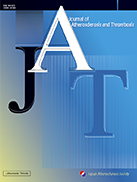Volume 28, Issue 5
Displaying 1-16 of 16 articles from this issue
- |<
- <
- 1
- >
- >|
Review
-
Subject area: Review
2021Volume 28Issue 5 Pages 417-434
Published: May 01, 2021
Released on J-STAGE: May 01, 2021
Advance online publication: March 19, 2021Download PDF (200K) Full view HTML -
Subject area: Review
2021Volume 28Issue 5 Pages 435-453
Published: May 01, 2021
Released on J-STAGE: May 01, 2021
Advance online publication: February 13, 2021Download PDF (188K) Full view HTML -
Subject area: Review
2021Volume 28Issue 5 Pages 454-466
Published: May 01, 2021
Released on J-STAGE: May 01, 2021
Advance online publication: March 06, 2021Download PDF (217K) Full view HTML
Editorial
-
Subject area: Editorial
2021Volume 28Issue 5 Pages 467-468
Published: May 01, 2021
Released on J-STAGE: May 01, 2021
Advance online publication: August 09, 2020Download PDF (73K) Full view HTML -
Subject area: Editorial
2021Volume 28Issue 5 Pages 469-470
Published: May 01, 2021
Released on J-STAGE: May 01, 2021
Advance online publication: November 13, 2020Download PDF (72K) Full view HTML -
Subject area: Editorial
2021Volume 28Issue 5 Pages 471-473
Published: May 01, 2021
Released on J-STAGE: May 01, 2021
Advance online publication: October 15, 2020Download PDF (122K) Full view HTML -
Subject area: Editorial
2021Volume 28Issue 5 Pages 474-476
Published: May 01, 2021
Released on J-STAGE: May 01, 2021
Advance online publication: September 10, 2020Download PDF (410K) Full view HTML
Original Article
-
Subject area: Original Article
2021Volume 28Issue 5 Pages 477-482
Published: May 01, 2021
Released on J-STAGE: May 01, 2021
Advance online publication: July 23, 2020Download PDF (212K) Full view HTML -
Subject area: Original Article
2021Volume 28Issue 5 Pages 483-490
Published: May 01, 2021
Released on J-STAGE: May 01, 2021
Advance online publication: August 29, 2020Download PDF (124K) Full view HTML -
Subject area: Original Article
2021Volume 28Issue 5 Pages 491-505
Published: May 01, 2021
Released on J-STAGE: May 01, 2021
Advance online publication: August 06, 2020Download PDF (531K) Full view HTML -
Subject area: Original Article
2021Volume 28Issue 5 Pages 506-513
Published: May 01, 2021
Released on J-STAGE: May 01, 2021
Advance online publication: August 27, 2020Download PDF (276K) Full view HTML -
Subject area: Original Article
2021Volume 28Issue 5 Pages 514-523
Published: May 01, 2021
Released on J-STAGE: May 01, 2021
Advance online publication: July 17, 2020Download PDF (157K) Full view HTML -
Subject area: Original Article
2021Volume 28Issue 5 Pages 524-534
Published: May 01, 2021
Released on J-STAGE: May 01, 2021
Advance online publication: July 23, 2020Download PDF (251K) Full view HTML -
Subject area: Original Article
2021Volume 28Issue 5 Pages 535-543
Published: May 01, 2021
Released on J-STAGE: May 01, 2021
Advance online publication: August 28, 2020Download PDF (208K) Full view HTML -
Subject area: Original Article
2021Volume 28Issue 5 Pages 544-554
Published: May 01, 2021
Released on J-STAGE: May 01, 2021
Advance online publication: August 15, 2020Download PDF (456K) Full view HTML -
Subject area: Original Article
2021Volume 28Issue 5 Pages 555-561
Published: May 01, 2021
Released on J-STAGE: May 01, 2021
Advance online publication: August 29, 2020Download PDF (152K) Full view HTML
- |<
- <
- 1
- >
- >|
